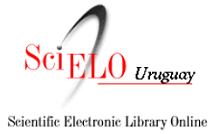Ácido oleico, ácidos grasos esenciales y ácidos grasos n-3 totales en la yema de huevos comercializados en supermercados de Montevideo
Palabras clave:
Ácidos grasos, Yema, Huevos comercialesResumen
The research determined the egg yolk fatty acids profile of twelve brands marketed in different supermarkets in Montevideo. The methodology was based on the extraction of total lipids with a mixture of chloroform and methanol (Folch). Methylation was done in cold with methanol-KOH and by gas chromatography (Clarus 500 Perkin Elmer) using a 100 meters CP-Sil88 capillary column and a flame detector (FID). This summary presents the composition (% of total fatty acids) in oleic acid, linoleic acid, α-linolenic acid, DHA, EPA and total n-3 fatty acids (omega 3). The results show a high presence of oleic acid (44-52 %), which could explains the resistance of eggs to lipid oxidation during storage at room temperature. This fatty acid is monounsaturated and resistant to lipid oxidation which protects, by barrier effect, the polyunsaturated fatty acids (PUFA) present in the yolk from oxidation. Linoleic and α-linolenic acids, both essential, have values ranged from 3-14 % for the first and 0.22-0.67 % for the second. For DHA and EPA the values ranged from 0.04-1.29 % for the first and 0.06-0.65 % for the second. Total content of n-3 fatty acids in the yolks ranged from 0.45-2.30 %. The n-3 fatty acids, particularly DHA and EPA, are important for the health of consumers. Hence the interest in evaluating the contribution in n-3 fatty acids of the eggs marketed in the country. Research shows that the amount of n-3 fatty acids in eggs is variable, probably due to a different diet of animals. This observation is particularly clear for DHA. The α-linolenic acid, a metabolic precursor of DHA and EPA, has a level in the yolks that varies little between most of the eggs studied (10 in 12 studied brands), indicating that birds received similar amounts in their diets. But the metabolic transformation of α-linolenic acid into DHA and EPA was not proportional to such level, probably due to a loss of the α-linolenic acid by oxidation. The differential presence of antioxidants in the diet of birds could explain, at least in part, the poor correspondence between the level of α-linolenic acid and DHA and EPA in the studied eggs. Ongoing studies in our laboratory are evaluating the validity of such hypothesis.
Palabras clave: Ácidos grasos, Yema, Huevos comerciales.
Descargas
Publicado
Cómo citar
Número
Sección
Licencia
Derechos de autor 2025 Sociedad de Medicina Veterinaria del Uruguay-Facultad de Veterinaria, Universidad de la República

Esta obra está bajo una licencia internacional Creative Commons Atribución 4.0.











